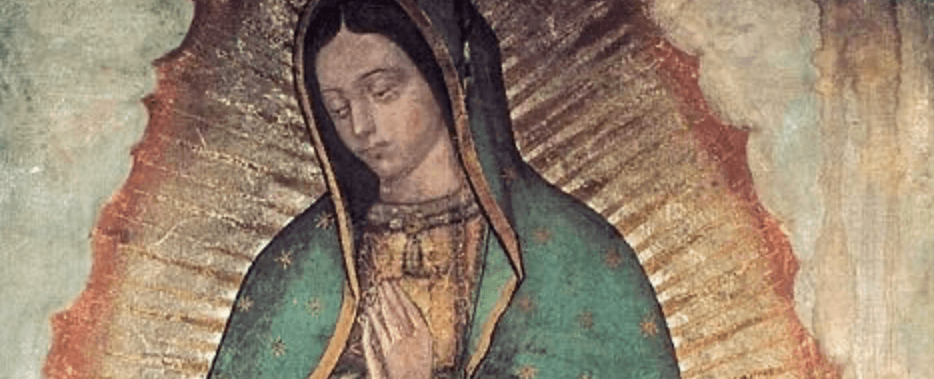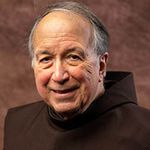Our Lady of Guadalupe and the Franciscans

On December 12, Catholics in the Americas celebrate the Feast of Our Lady of Guadalupe, which today is the most popular Christian shrine in the world. Franciscans were there at the beginning of this story.
The fundamental source document here is the Nican Mopohua (“Here is recounted”), which narrates a series of apparitions of the Virgin Mary, in the guise of an indigenous woman, to an indigenous man, Juan Diego Cuauhtlatoatzin (“The Talking Eagle”), on December 9, 10, and the culminating day, December 12, 1531. She asked him, in his language, that a shrine be built in her honor on Tepeyac, a hill located in present-day Mexico City. The document is written in elegant classical Nahuatl (the official language of the Aztec Empire).
Franciscans: First to arrive on the scene
It is important to understand the timeline here. After the fall of the Aztec Empire (1519-21), conquistador Hernán Cortés turned to the immense task of the evangelization of the native population, which he preferred to be in the hands of the mendicant orders. The Franciscans were first to arrive on the scene: Blessed Pedro de Gante (Peter of Ghent) arrived with two companions in 1523, but a larger group, the famous “Twelve Apostles” of Mexico, arrived from Extremadura in Spain in 1524. The dynamic work of these Franciscans marked the beginning of the systematic evangelization of the indigenous peoples of Mexico.
Mural depicting Hernán Cortés greeting the first 12 Franciscan friars in Tenochtitlan, by unknown painter from the 16th century. At the Immaculate Conception Church in Ozumba, Mexico State.
Apparitions of Our Lady of Guadalupe to Juan Diego
Juan Diego and his wife were baptized by one of these friars, probably in 1525. It seems from the Nican Mopohua that as a recent convert Juan was continuing to attend follow-up instruction classes. It was to this humble “macehualtzin” – “a poor man of the people” – that Mary chose to reveal herself.

Modern depiction of Saint Juan Diego, canonized in 2002 by Pope John Paul II.
The role of the Franciscan Bishop of Mexico
Then, a key role was played by the newly-arrived Juan de Zumárraga, OFM (1468-June 3, 1548), who had been designated as Bishop of Mexico. After a couple of days of hesitation, he accepted the authenticity of the apparition of the Virgin of Guadalupe to the simple Juan Diego, who had agonized about going to the bishop. According the Nican Mopohua, although Juan Diego doubted his ability to carry Mary’s message to the bishop, he placed his faith in the Holy Mother, “my little Virgin,” while Juan de Zumárraga at first was doubtful and skeptical but was willing to be open. Ultimately, they met.

Juan de Zumárraga, OFM (1468–1548), a Basque Spanish friar and first bishop of Mexico, made great efforts to evangelize the indigenous peoples. He is credited with making chocolate a popular drink among Europeans.
Learn more about Our Lady of Guadalupe
Finally, who was the author of the Nican Mopohua? By far the leading candidate is Antonio Valeriano (1521?-1605), an indigenous scholar born just before the fall of Tenochtitlan; he was apparently from the Aztec nobility. Valeriano was the most accomplished pupil at the Franciscan Colegio de Santa Cruz de Tlatelolco, becoming a respected collaborator of friar Bernardino de Sahagún, eventually serving as the royal “Judge-Governor” of México-Tenochtitlan for over a quarter of a century, from 1573 to 1599. He is generally thought to have put the Nican Mopohua together about 1555 (about a quarter century after the events) from stories circulating at that time. The earliest printed edition now known dates from 1649, about ninety years after the work was composed.
Read this fascinating source, the Nican Mopohua, in English for yourself.
Read a beautiful reflection written by Pope Francis several years ago on the continuing significance of Our Lady of Guadalupe (Spanish text first, then English translation).

Interior of the new basilica of Our Lady of Guadalupe in Mexico City, which houses the original image, was constructed between 1974 and 1975 (photo by J. D. Garcia).
Main image: The image of Our Lady of Guadalupe in her basilica, Mexico City.
Dominic Monti, OFM
Professor of Franciscan Research in the Franciscan Institute of St. Bonaventure University
Dominic V. Monti, OFM, is a Franciscan Friar of Holy Name Province (USA) and currently professor of Franciscan Research in the Franciscan Institute of St. Bonaventure University. He devoted the greater part of his ministry to teaching the History of Christianity, in particular the history of the Franciscan movement. He has contributed two volumes to the Works of St. Bonaventure series and is author of Francis & His Brothers, a popular history of the Friars Minor.


